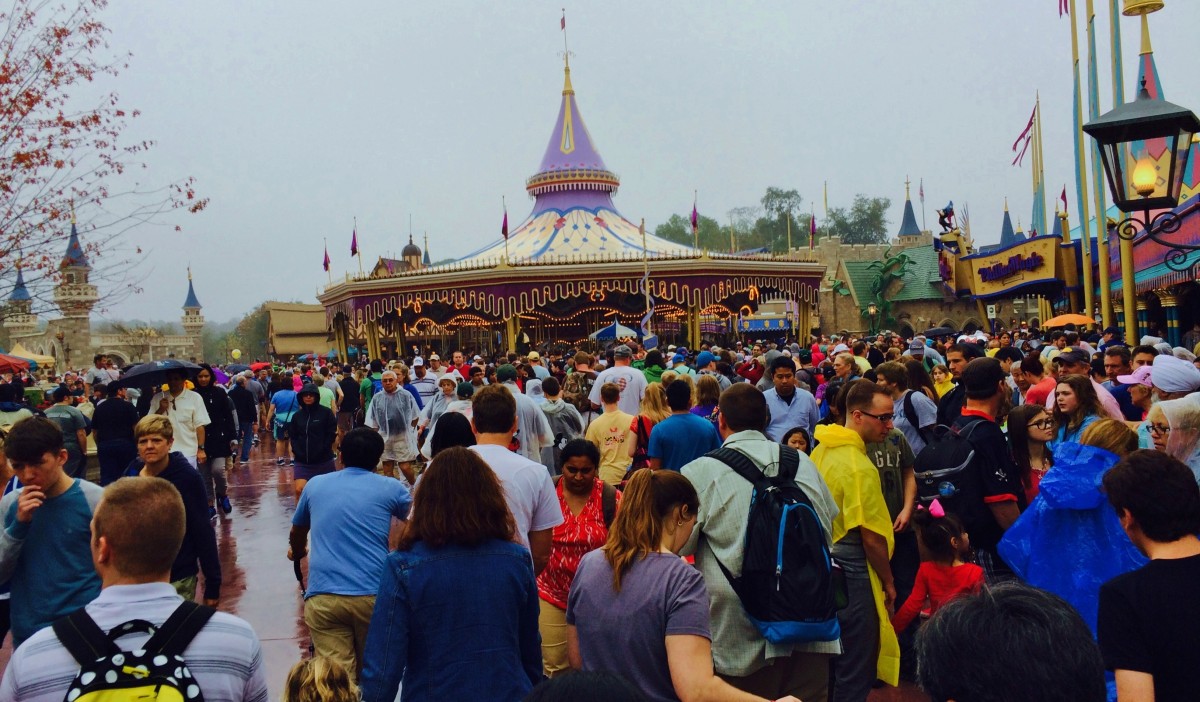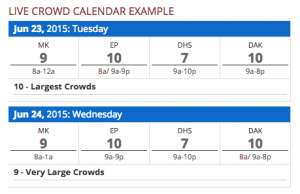
Key to Vacation Happiness: Realistic Expectations
Take a vacation to Walt Disney World and you’ll inevitably see a family having an experience that doesn’t quite live up to “the happiest place on Earth.”
Kids crying, parents grumbling through gritted teeth, “do you know how much I paid for this vacation?” It’s a far cry from the image of kids embracing a character in front of Cinderella’s Castle in a virtually empty Magic Kingdom that is portrayed in the commercials for Walt Disney World. But crowds, confusion and chaos can diminish a Disney vacation that a family has built up as the trip of a lifetime.

So how do you make sure that your trip to the happiest place on Earth is just that? A recent study posits that the key to happiness is low expectations. Dr. Robb Rutledge, the senior research associate at University College London (UCL) who led the study, stated, “Lower expectations make it more likely that an outcome will exceed those expectations and have a positive impact on happiness.”
It makes some sense, except that no one visiting the Disney parks, should have low expectations. A better way to look at it is that someone planning their first Disney vacation should have realistic expectations. If you know exactly what you’re getting into, you’re much more likely to see your trip meet or exceed expectations. And if you’re reading a blog like this, you’re probably way ahead of most visitors.
When I first brought my family to Walt Disney World in 2009, I figured it would be our one and only Disney trip. So I wanted to do it right. That meant reading everything I could get my hands on – books, blogs and message boards; listening to the advice on Disney podcasts; and making smart use of a touring plan. Was the trip a success? The fact that I’ve returned five more times since then should make the answer clear.
Read on to learn more about how to keep your expectations realistic and your vacation happy.
Learn the lingo
For the first-time visitor, there is a learning curve, including the jargon and shorthand used by seasoned veterans, many of whom will use acronyms for attractions, resorts and events. Luckily, if you’re confused by anything, you can often do a search on message boards to find your answer. Here’s a helpful link on the Touring Plans forum. But beyond knowing what those acronyms mean, it’s important to know how things like FastPass+ and ADRs (advance dining reservations) work. (This is also one of the reasons for our recent series of Basics posts, including FastPass use and strategy as well as Dining.)

A big part of that knowledge is being aware of the deadlines and preparing yourself to begin making your ADRs 180 days in advance and your FastPass+ reservations 60 days in advance. It’s important to be aware of the high-demand venues to target first, for example, dining reservations at Be Our Guest or reservations for the 7 Dwarfs Mine Train in the Magic Kingdom. It’s also important to know that you can make many of your reservations beyond that 180/60-day limit. That’s because you can make reservations for the length of your stay as soon as you reach the reservation window for the first day of your trip.
These deadlines apply to guests who are staying on property, which speaks to another argument for the first-time visitor to plan their trip at a Disney resort, rather than an off-property hotel. If you’re staying off property, you can still make dining reservations 180 days in advance, but you can’t use the length of your trip as a hedge. For FastPass+, you’re only going to be able to reserve 30 days in advance, which may limit your options for popular attractions.
There will be crowds
The recent announcement that Disney Co. is going to tiered pricing on its one-day park tickets is part of an overall strategy to even out crowds throughout the year. The days of finding an empty park during off-peak seasons are unfortunately long gone. No matter when you visit, you will encounter crowds. But good planning can minimize the impact of the hordes.

The first thing to realize is that crowd levels will vary between parks on the same day. Park hours, Extra Magic Hours, events and even days of the week can have an impact. This means that the first step in planning will be taking a look at a crowd calendar like the one on this site. Figure out a day-by-day plan that will keep you out of the most crowded parks. Once you’ve determined which park you will be in each day, you can plan your dining reservations to be in or near your destination park and later plan your FastPass+ reservations.
When I was a first-timer, the touring plans from this site were an invaluable tool. I had never set foot in the parks and had no clue about crowd patterns. Having printouts of a step-by-step touring plan gave us a simple-to-follow road map to avoid the long lines and still get on every attraction we wanted to ride. This was back in the day of paper FastPass, which meant often running from one part of the park to another to gather FastPasses for the family. FastPass+ has eliminated the need to run across the park for your paper FastPass, but it does place a priority on the advance planning.
You’re not going to see everything
Even if you’re spending a full week at Walt Disney World, count on not seeing half of the attractions and shows. With four theme parks, there simply is not enough time to see everything (except for the current iteration of Disney’s Hollywood Studios, but that’s another discussion). Keep the expectation of the attractions you want to experience realistic. If you have young children, you’re better off planning a reasonable pace for your vacation with ample time for sleep and breaks. Exhaustion is probably the cause of most in-park meltdowns. Don’t let it happen to you.
Now that you know you’re not riding everything, you’ll want to research in advance with your family to find out which attractions are must-see and which can be skipped or saved for the next trip. Disney will mail you a free trip planning DVD, which is great fun to pop in and watch with the family, but I find guidebooks the most helpful resource. I’ll give particular props to “The Unofficial Guide to Walt Disney World” for providing frank, honest reviews of attractions, outlining their features, average waits and appeal to various age groups.
Once you have the list of must-see attractions your family has picked, you can incorporate those into your FastPass+ reservations and touring plan. Rather than being a chore, you’ll likely find that all this prep work will only build your excitement for your Disney vacation.
Spontaneity takes planning

A highlight moment from our first trip happened on the final night of our trip, which happened to be my birthday. We had dinner at Rose & Crown in Epcot with a prime viewing spot for IllumiNations: Reflections of Earth. At one point, I guided my young son through the pub to the bathrooms. To get there, we passed by the Hat Lady playing piano for an enthusiastic crowd. My son got in the spirit and began dancing, drawing cheers from the crowd. When the song was completed he went up to the Hat Lady and told her, “It’s my dad’s birthday.” Of course, she launched into a rendition of “Happy Birthday” and soon the whole pub was singing to me. My son was absolutely beaming.
No, it’s not your typical Disney moment, but it’s the kind of experience that happens on a Disney vacation — an unforgettable memory created when you least expect it on a routine trip to the bathroom. The point of my story is that this experience wouldn’t have happened had we not spent time to pick our dining preferences six months before our trip, getting us a reservation that’s in high demand thanks to the prime viewing location for Epcot’s fireworks.
And it’s also a lesson that extensive planning doesn’t remove the opportunity for unexpected magic, rather it creates opportunities. When you have the basics of your trip covered in advance — the attractions you’re visiting, the places you’re eating, you can relax and allow the rest of the vacation come to you. Soak in the details of the park, chat up a cast member, let your kids romp in a play area longer while they’re having fun. And when the unexpected happens? Well, that’s the good stuff that will have you planning your next trip as you ride that Magical Express bus back to the airport.





As an example of spontaneity, we were in AK a couple years ago and were following a touring plan. After lunch we were ahead of our plan and my 6 year old daughter sees Goofy and Pluto and wants to meet them. We get in line and a couple minutes later a cast member starts talking to my daughter. General stuff like “Where you from?” “Having fun?” Then it goes like this:
CM: “Do you like parades?”
Daughter: “Yea, I guess.”
CM: “Are you going to watch the Jammin’ Jungle parade today?”
Daughter: “Yes, my mom can’t wait.”
CM looks at me and the looks back at my daughter and asks:
“Would you like to be in the parade?”
Daughter: “DADDY, CAN WE?”
Unfortunately, a severe thunder storm rained out the parade that day, but we did get to go backstage and get some really great pictures in the safari costumes we would have been wearing. They did offer to let us be in the parade a different day, but we couldn’t get back to AK before our trip ended.
If we hadn’t gotten into line to see Goofy and Pluto (whom we had already met in different parks), we wouldn’t have had that potentially once in a lifetime opportunity. As it is, we still think of that as a highlight of the trip.
Great article. There are many facets to setting realistic expectations, esp. w/ regard to children. You can’t do everything is a biggie, and also, you might be surprised by what the kids do/don’t enjoy throughout the trip. E.g, my Star Wars-obsessed 8 year-old nephew was underwhelmed by Star Tours and decided to skip the Jedi Training Academy (too many younger kids) but totally loved the Indiana Jones Stunt Spectacular (a film franchise he’d never even seen). He was kind of jaded at MK (w/ some exceptions, e.g. Splash Mountain), and seemed to enjoy the pool at the Wilderness Lodge above all else.
Also, when planning trips with extended family/larger groups, don’t expect that you’ll be able to tour together all the time. Based on experience, I think it’s better if each individual family books their own fast passes and generally creates their own touring plan (or split up by age or whatever makes sense, e.g. all the teens tour together); the larger group can always come together for meals, downtime at the hotel, etc.
Yes! A good attitude, & planning 😉
Rest/breaks, nutrition & hydration are also key. Comfort- definitely wear good shoes & sunscreen. Plan some pre-trip walking to increase your stamina if you don’t normally do 5 miles a day. Who does? ¯\_(ツ)_/¯
Just traveling to WDW is usually tiresome. Don’t start your vaca already sleep deprived. Don’t go to bed late the night before your trip because you’re still packing & running to Walgreens, lol.
Yes, you need to plan. I took my friend to Disney, her first trip, and she could not believe the amount of planning I did. When we got there, she thanked me every day because we did not wait in line more than 25 minutes, hit all the major highlights, and ate at prime time at the best restaurants. We had plenty of magical moments throughout our stay. Planning works!
I have family members who refer to their one and only WDW vacation as the “Disney Death March” because they managed to do every thing you’re NOT supposed to do on these vacations. They are puzzled by our love of Disney and the fact that our young children love going. I keep pointing out that a vacation is what you make of it – through planning, attitude and/or flexibility. I will show them your article as proof! :o)